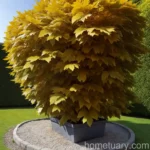European Beech (Fagus sylvatica ‘Tricolor’)
In the world of horticulture, the European beech (Fagus sylvatica ‘Tricolor’) stands out as a true gem. With its striking foliage and versatility, this plant has captured the attention of gardeners and landscape enthusiasts around the globe. In this comprehensive guide, we will delve into the various aspects of the European beech, exploring its characteristics, care requirements, uses, and much more.
What is Fagus sylvatica ‘Tricolor’?
Fagus sylvatica ‘Tricolor,’ commonly known as the European beech, is a captivating ornamental tree prized for its stunning variegated foliage. This deciduous tree belongs to the Fagaceae family and is native to Europe, where it is often found in woodlands and parklands.
The ‘Tricolor’ variety is celebrated for its remarkable leaves, which showcase an enchanting blend of green, creamy white, and pinkish-red hues. This tri-color effect adds a touch of elegance and vibrancy to any landscape, making the European beech a highly sought-after ornamental specimen.
Key Takeaways
Before delving into the details of European beech care, it’s beneficial to highlight some key takeaways about this remarkable plant:
- Fagus sylvatica ‘Tricolor’ Characteristics: Known for its striking tri-colored foliage, the European beech adds visual interest to any setting.
- European Beech Tree Varieties: The Fagus sylvatica species boasts several other notable varieties, each with its own unique characteristics and appeal.
- Fagus sylvatica ‘Tricolor’ Care Guide: Understanding the specific care requirements of ‘Tricolor’ European beech trees is essential for their successful cultivation.
- European Beech Foliage Colors: The enchanting foliage of ‘Tricolor’ European beech trees evolves throughout the seasons, offering an ever-changing display of colors.
- Growing Fagus sylvatica ‘Tricolor’: Cultivating a thriving European beech tree requires attention to its growth habits and environmental needs.
- European Beech Tree Uses: From ornamental planting to wildlife habitat creation, the European beech serves various practical and ecological purposes.
- Fagus sylvatica ‘Tricolor’ Planting Tips: Knowing the optimal planting techniques for ‘Tricolor’ European beech trees is crucial for their establishment and growth.
- European Beech Tree Facts: Exploring interesting facts about ‘Tricolor’ European beech trees adds depth to our understanding of this captivating species.
- Fagus sylvatica ‘Tricolor’ Maintenance: Regular maintenance practices contribute to the health and beauty of European beech trees.
- European Beech Tree Diseases: Identifying and managing potential diseases is an integral part of European beech tree care.
Through a comprehensive exploration of these key takeaways, we aim to provide an in-depth understanding of the European beech (Fagus sylvatica ‘Tricolor’) and equip enthusiasts with the knowledge to nurture and appreciate this exceptional plant.
Culture
Water
Proper watering is crucial for the health and vigor of the European beech, especially in its early establishment phase. When it comes to watering ‘Tricolor’ European beech trees, it’s essential to strike a balance to avoid water stress or waterlogged conditions.
Here are some guidelines for watering European beech trees:
-
Establishment Period: During the initial two years after planting, ‘Tricolor’ European beech trees require consistent moisture. Ensure that the soil is evenly moist, but not waterlogged, to support healthy root development.
-
Mature Trees: Once established, European beech trees exhibit good tolerance to drought conditions. However, during prolonged dry spells, it’s beneficial to provide supplemental watering, particularly for trees growing in sandy or well-draining soils.
-
Avoid Overwatering: European beech trees are sensitive to waterlogging, which can lead to root rot and other issues. Always assess soil moisture levels before watering and adjust the frequency based on environmental conditions.
Sunlight
European beech trees thrive in partially shaded to fully…
(continues)















